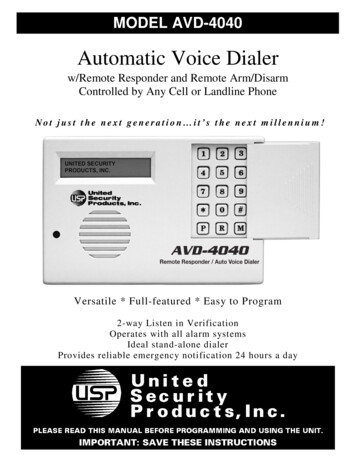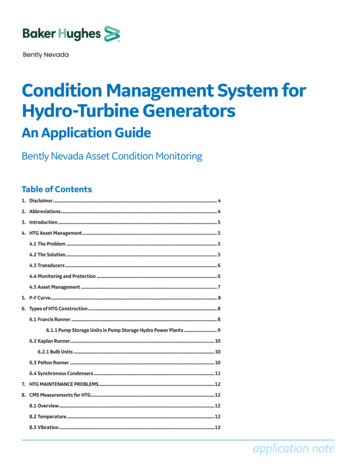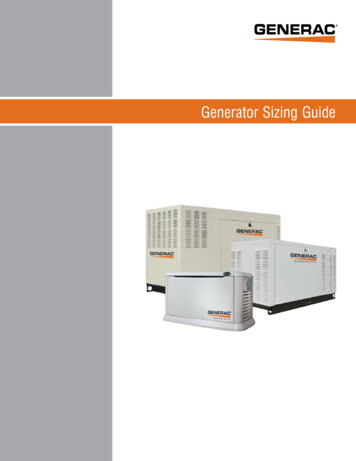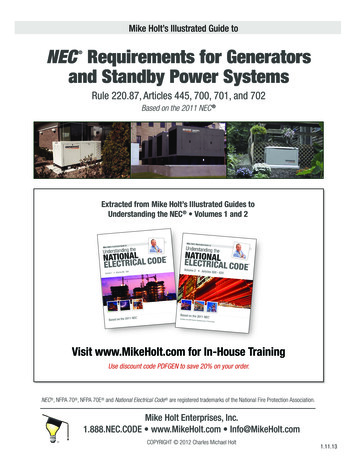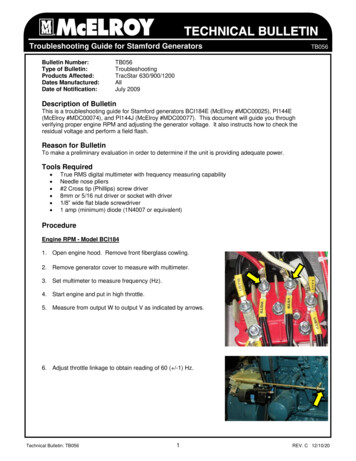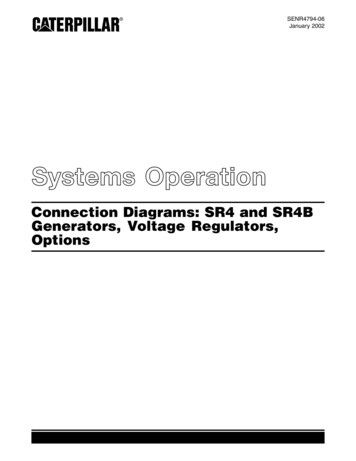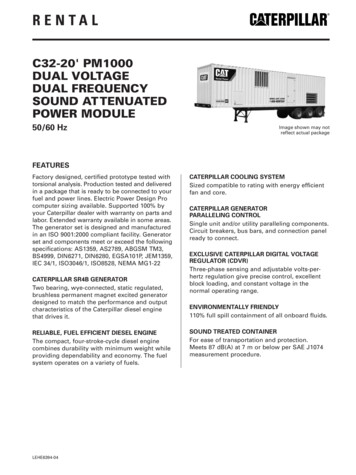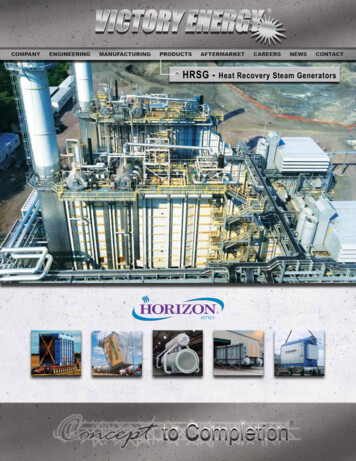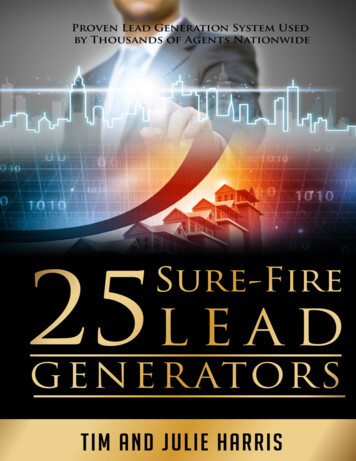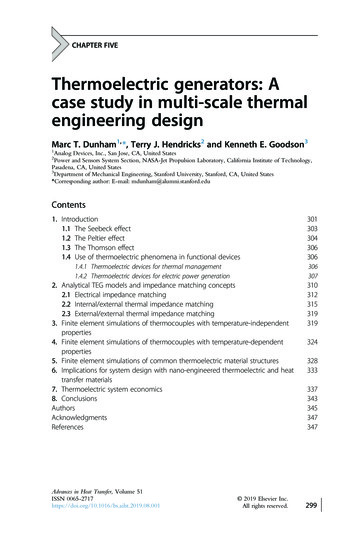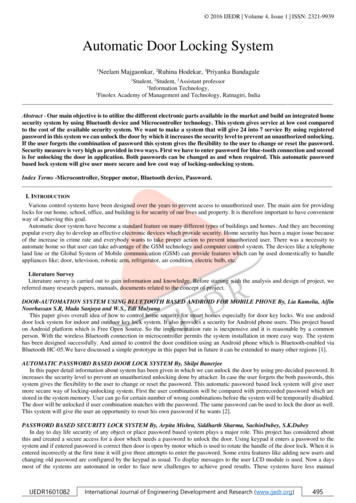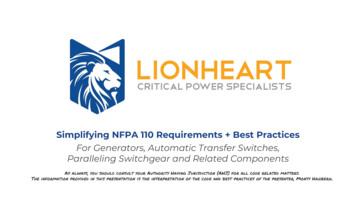
Transcription
1WELCOME TOSimplifying NFPA 110 Requirements Best PracticesFor Generators, Automatic Transfer Switches,Paralleling Switchgear and Related ComponentsAs always, you should consult your Authority Having Jurisdiction (AHJ) for all code related matters.The information provided in this presentation is the interpretation of the code and best practices of the presenter, Monty Hagberg.
2A LITTLE ABOUT US- Established in 1999- Service over 3,000 unique accounts- Not affiliated with any Original Equipment Manufacturer- Provide more technically-competent services and solutionsthan OEM competitors by focusing on maintenance,repairs, replacements and upgrades - not generator sales.- Veteran Owned- Most EGSA Certified Journeymen in the Midwest- In-House 24/7 Engineering Team- Comprehensive On-Site Training
A little aboutyour presenters:Monty AND Jordan- A combined 23 years of generator servicesupport & sales to engineers, plantoperations professionals, and facilitydirectors just like you.- Most times, this training is providedin-person, on-site with your own equipment.- Other times are in-person for large groups.- This is our first remote webinar .We need your questions to take it to thenext level for everyone!!!And, if you help by asking questions 3
4
5WHOA THERE PAL YOURSKINAlways wearsafety glassesAlways wearear protectionAlways wearflame retardantclothing andgloves
WHOA THERE PAL TYOURSKINAlways wearsafety glassesAlways wearear protectionAlways wearflame retardantclothing andgloves
WHOA THERE PAL TYOURSKINAlways wearsafety glassesAlways wearear protectionAlways wearflame retardantclothing andgloves
NFPA 110So .What’s New?The first round of changes in 13 years!!!Sometimes change can be uncomfortable .8
NFPA 1109So .What’s New?But we want you to be comfortable with THESE changes!!Here are a few key differences between the previous edition (1999) and the 2010 edition:-Differentiation between Diesel and Natural Gas generatorsAnnual Load Bank Testing duration is reduced and testing levels are relaxed4-hour Load Testing is required for all generators every 36 monthsFuel Quality Test is required annuallyTransfer Switch Maintenance and Testing Program is requiredParalleling Switchgear Maintenance and Testing Program is requiredBreaker exercising and testing is requiredMaintenance-free batteries are allowedA monthly-style test is required after repairs that “impact” operational reliability
NFPA 11010Key TermsLevel 1 vs. Level 2 SystemsLevel 1 systems refer to systems that are essential for safety to human life. For the sakeof this discussion, were going to be talking about Level 1 systems.PercentagesWhen NFPA provides required percentages that must be met during testing, it isreferring to the percentage of the rated kW percentage for the generator.Spark-ignitedFor this presentation, I will address spark-ignited as NATURAL GAS fueled enginesEPSS Emergency Power Supply SystemThis term encompasses the generator(s), transfer switches, and related components
11Let’scruise.throughthedaily,weekly& monthlyrequirements
DAILYGENERATORNFPA Requirements- NoneBest Practices- Visual Inspection12TRANSFER SWITCHNFPA Requirements- NoneBest Practices- Visual InspectionLeaks, alarms, debris,Fault lights, position lights,batteries, andand messages on themessages on thecontrol panelcontrol panel
Our guide to a13VISUAL INSPECTIONLEAKSLook for leaks under theradiator, near the front ofthe engine, and at theblock heater.DEBRISLook for signs of rodentnesting and look for debrisnear the radiator.ALARMSBATTERIESLook for alarmsor messages atthe generatorcontrol panels,remoteannunciatorpanels, and ATSpanels.Look for pooling ofelectrolyte on top of thebatteries, and look forcorrosion on batteryterminals.
WeeklyGENERATORTRANSFER SWITCHNFPA RequirementsNFPA Requirements- Visual Inspection andDocumentation- Inspected weekly- Specifically calls-outinspecting electrolyte levels(or battery voltage formaintenance free batteries)Best Practices- Run the generator for 10minutes to ensure properstart, no leaks, and theabsence of alarms orwarningsBest Practices- Visual Inspection of theexterior, lamps, andcontrol panel14
MonthlyGENERATORNFPA RequirementsDiesel Generator Testing- Operate the generator under building loadfor a minimum of 30 min.- To be exempt from annual load bank testing,load the generator to 30% or more- (or maintain the minimum exhaust gastemperature recommended by the OEM but this info is not available in most cases)Natural Gas Generator Testing- Operate the generator with the EPSS load for30 minutes or until the water temperatureand oil pressure have stabilizedBest Practices- Natural Gas generators should ran aFULL 30 minutes for the monthlytest (just like diesel generators)15TRANSFER SWITCHNFPA Requirements- Operate all connectedtransfer switches once permonthBest Practices- Rotate the ATS used toinitiate each monthlytest (to confirm theoperation of each ATS’sstart signal)
BATTERIES16They Get their own slidebecause they’re that important!Maintenance Free Batteries( YES! They are allowed! )Maintainable BatteriesNFPA RequirementsNFPA RequirementsWEEKLYWEEKLY- Inspect Electrolyte Levels in all battery cells.MONTHLY- Inspect battery VoltageMONTHLY- Complete and document the testing ofElectrolyte Specific Gravity in all cellsNOTE:- Complete and document abattery Conductance TestNFPA‐110 recommendsbatteries be replaced every 24‐30months (A.5.6.4.5.1)Here is a recommended conductance testing fromSnap-On. Let us know if you want additionalinformation!!
BATTERIES17(They Get their own slidebecause they’re that important!)Since the adoption of the 2012 Life Safety Code in 2016, dozens of our clients have requestedtheir starting batteries be replaced with Maintenance Free batteries.The requests are due to Joint Commission’s enforcement of OSHA Instruction STD 01-08-002which requires eyewash stations in battery charging and maintenance areas.
Annually18
AnnuallyGENERATORNFPA RequirementsDieselNatural GasEngine and Generator Maintenance- “Manufacturer's recommendedMaintenance” to include inspection,testing all the main systems:- Starting/Electrical- Fuel- Cooling- Lube Oil- Air Intake/Exhaust- Controls and SafetiesLoad Bank Testing - No longerrequired for natural gas generatorsBest Practices- Natural Gas generators should beload bank tested annuallyWe identify more problems withthe stability of natural gas enginesthan with diesel engines- Laboratory analysis of oil andcoolant samplesEngine and Generator Maintenance- “Manufacturer's recommendedMaintenance” to include inspection, testingall the main systems:- Starting/Electrical- Fuel- Cooling- Lube Oil- Air Intake/Exhaust- Controls and SafetiesLoad Bank Testing - If the monthlytesting documentation does not meetthe required load levels or exhausttemperatures, an annual Load Test isrequired. This test is typically performedwith a load bank so the testing level canbe 75% or greater for the last hour.Load bank testing duration has beenreduced from 2 hours to 1.5 hoursLoad levels have been “relaxed”Fuel Testing - Required19TRANSFER SWITCHNFPA Requirements- Transfer switches shall be subjected to amaintenance and testing program toinclude:-checking connectionsinspection for overheatingchecking for excessive contact erosionremoval of dust and dirtreplacement of contacts, if necessaryBest Practices- In addition to NFPA Requirements, we recommendadding the following to annual switch maintenance:- Infrared scans or thermography of all cableconnection points and the contactor assembly- Operation and testing of the bypass module if theATS is a Bypass/Isolation switch- Confirm all time delays and pick-up / drop outsettings
AnnuallyGENERATORNFPA RequirementsFor Diesel Generators: A fuel quality test must be performedannually using testing approved by ASTM standards.But which ATSM standards? Please share what you know.20
AnnuallyYour Paralleling Switchgear needs some love too!PARALLELING SWITCHGEARNFPA Requirements- Paralleling switchgear shall be subjected to amaintenance and testing program toinclude:-checking connectionsinspection for overheatingchecking for excessive contact erosionremoval of dust and dirtreplacement of contacts, if necessaryBest PracticesFull function test to include all paralleling operations!21
AnnuallyYep! There’s More! Let’s Talk Breakers .BREAKERSNFPA Requirements- Circuit breakers including main and feed breakers between thegenerator and the transfer switch shall be exercised.- If circuit breaker is in excess of 600v - it shall be exercised every 6months and tested under overload conditions every 2 years.Best PracticesAnnual generator maintenance includes exercising the output breaker on thegenerator, HOWEVER ---- we suggest discussing this requirement with yourelectrician or the vendor who performs breaker maintenance on your utilityswitchgear.22
Triennially.23(36 months)GENERATORTRANSFER SWITCHNFPA RequirementsNFPA RequirementsNatural GasDiesel- 4-hour Load Test. Must be- 4-hour Load Test. Can beperformed at equal to or greaterperformed with building loadthan 30% for 4 continuous hours(ATSs in EM position for 4continuous hours).- If combined with an annual 1.5hour test, the last hour must beequal to or greater than 75%Best Practices- Natural Gas generatorsshould be tested with aload bank to ensure properoperation at heavy load.- If combined with a monthly 30minute test, the test must beinitiated with an ATS and allconnected ATSs must betransferred during the test.- NoneBest Practices- No special recommendations forevery 36 months, however werecommend powering-downeach ATS every 5 years to torquelugs and cable connections
WARNING!!!!!12 Slides of NFPA 110 code details are coming!Hang in there.we’re in the final stretch.(This is a good time to jot down questions :-)
NFPA-110, 2010 editionChapter 8 Routine Maintenance and Operational Testing
8.1* General8.1.1 The routine maintenance and operational testing programshall be based on all of the following:(1) Manufacturer’s recommendations(2) Instruction manuals(3) Minimum requirements of this chapter(4) The authority having jurisdiction8.1.2 Consideration shall be given to temporarily providing aportable or alternate source whenever the emergency generatoris out of service.
8.2* Manuals, Special Tools, and Spare Parts.8.2.1 At least two sets of instruction manuals for all major components ofthe EPSS shall be supplied by the manufacturer(s) of the EPSS and shallcontain .8.2.3 Special tools and testing devices necessary for routine maintenanceshall be available for use when needed.8.2.4 Replacement for parts identified by experience as high mortalityitems shall be maintained in a secure location(s) on the premises.8.2.4.1 Consideration shall be given to stocking spare parts asrecommended by the manufacturer.
(TESTING FOLLOWING REPAIRS)8.3 Maintenance and Operational Testing8.3.2 A routine maintenance and operational testing program shall beinitiated immediately after the EPSS has passed acceptance tests or aftercompletion of repairs that impact the operational reliability of the system.8.3.2.1 The operational test shall be initiated at an ATS and shall includetesting of each EPSS component on which maintenance or repair has beenperformed, including the transfer of each automatic and manual transferswitch to the alternate power source, for a period of not less than 30 minutesunder operating temperature.
(ATS MAINTENANCE REQUIREMENT)8.3.5* Transfer switches shall be subjected to a maintenance and testingprogram that includes all of the following operations:(1) Checking of connections(2) Inspection or testing for evidence of overheating and excessive contacterosion(3) Removal of dust and dirt(4) Replacement of contacts when required
(PARALLELING GEAR MAINTENANCE REQUIREMENT)8.3.6 Paralleling gear shall be subject to an inspection, testing, andmaintenance program that includes all of the following operations:(1) Checking of connections(2) Inspection or testing for evidence of overheating and excessive contacterosion(3) Removal of dust and dirt(4) Replacement of contacts when required
(BATTERY REQUIREMENTS)8.3.7* Storage batteries, including electrolyte levels or battery voltage, usedin connection with systems shall be inspected weekly and maintained in fullcompliance with manufacturer’s specifications.8.3.7.1 Maintenance of lead-acid batteries shall include the monthly testingand recording of electrolyte specific gravity. Battery conductance testing shallbe permitted in lieu of the testing of specific gravity when applicable orwarranted.8.3.7.2 Defective batteries shall be replaced immediately upon discovery ofdefects.
(BREAKER EXERCISE & TESTING REQUIREMENT)8.4.7 EPSS circuit breakers for Level 1 system usage, including main andfeed breakers between the EPS and the transfer switch load terminals, shallbe exercised annually with the EPS in the “off” position.8.4.7.1 Circuit breakers rated in excess of 600 volts for Level 1 system usageshall be exercised every 6 months and shall be tested under simulatedoverload conditions every 2 years.
(FUEL QUALITY TESTING REQUIREMENT)8.3.8 A fuel quality test shall be performed at least annuallyusing tests approved by ASTM standards.
(MONTHLY INSPECTIONS & TESTING)8.4 Operational Inspection and Testing8.4.1* EPSSs, including all appurtenant components, shall be inspectedweekly and exercised under load at least monthly8.4.2* Diesel generator sets in service shall be exercised at least oncemonthly, for a minimum of 30 minutes, using one of the following methods:(1) Loading that maintains the minimum exhaust gas temperatures asrecommended by the manufacturer(2) Under operating temperature conditions and at not less than
NFPA 110 10 Key Terms Level 1 vs. Level 2 Systems Level 1 systems refer to systems that are essential for safety to human life. For the sake of this discussion, were going to be talking about Level 1 systems. Percentages When NFPA provides required percentages that must be met during testing, it is referring to the percentage of the rated kW percentage for the generator. Spark-ignited For this .
